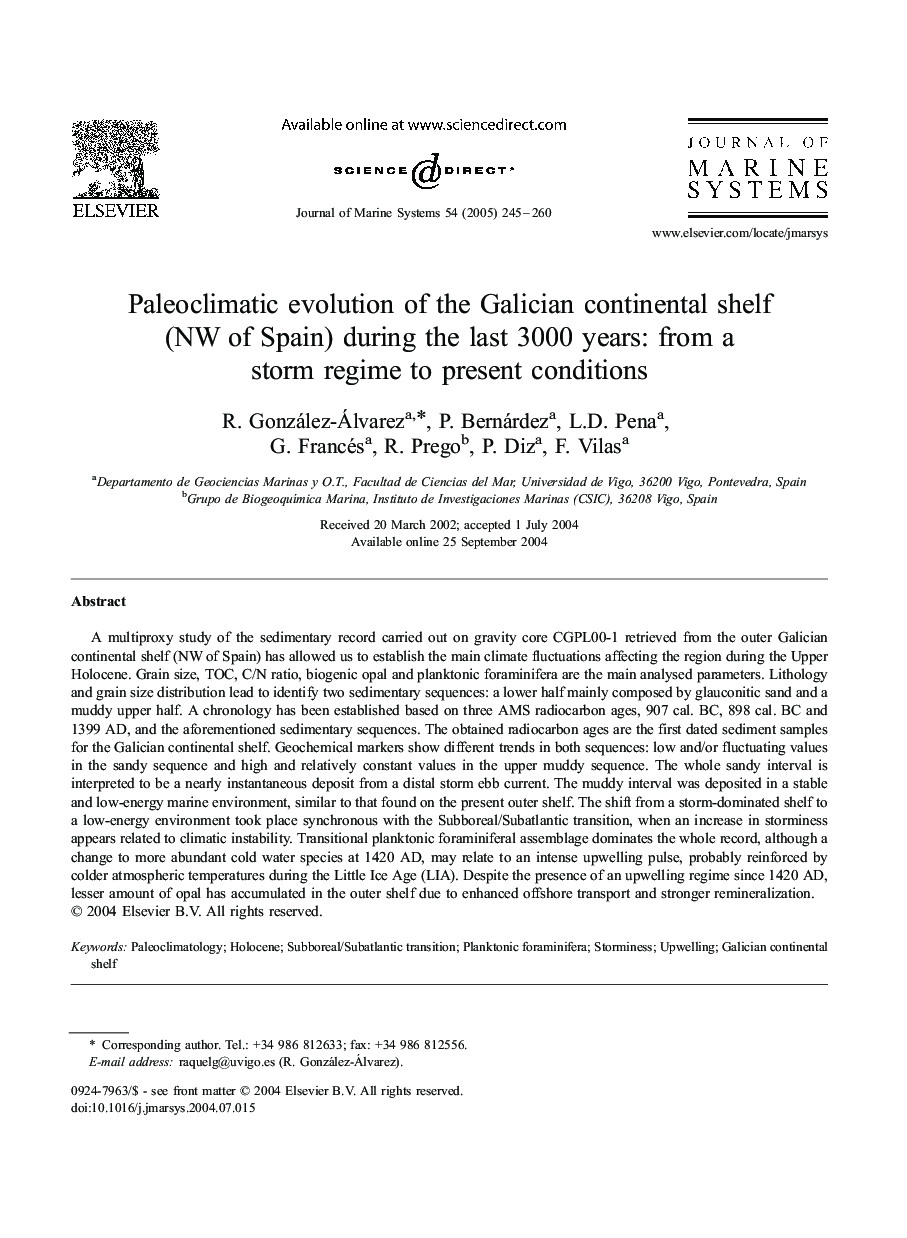| کد مقاله | کد نشریه | سال انتشار | مقاله انگلیسی | نسخه تمام متن |
|---|---|---|---|---|
| 9483452 | 1627378 | 2005 | 16 صفحه PDF | دانلود رایگان |
عنوان انگلیسی مقاله ISI
Paleoclimatic evolution of the Galician continental shelf (NW of Spain) during the last 3000 years: from a storm regime to present conditions
دانلود مقاله + سفارش ترجمه
دانلود مقاله ISI انگلیسی
رایگان برای ایرانیان
کلمات کلیدی
موضوعات مرتبط
مهندسی و علوم پایه
علوم زمین و سیارات
اقیانوس شناسی
پیش نمایش صفحه اول مقاله

چکیده انگلیسی
A multiproxy study of the sedimentary record carried out on gravity core CGPL00-1 retrieved from the outer Galician continental shelf (NW of Spain) has allowed us to establish the main climate fluctuations affecting the region during the Upper Holocene. Grain size, TOC, C/N ratio, biogenic opal and planktonic foraminifera are the main analysed parameters. Lithology and grain size distribution lead to identify two sedimentary sequences: a lower half mainly composed by glauconitic sand and a muddy upper half. A chronology has been established based on three AMS radiocarbon ages, 907 cal. BC, 898 cal. BC and 1399 AD, and the aforementioned sedimentary sequences. The obtained radiocarbon ages are the first dated sediment samples for the Galician continental shelf. Geochemical markers show different trends in both sequences: low and/or fluctuating values in the sandy sequence and high and relatively constant values in the upper muddy sequence. The whole sandy interval is interpreted to be a nearly instantaneous deposit from a distal storm ebb current. The muddy interval was deposited in a stable and low-energy marine environment, similar to that found on the present outer shelf. The shift from a storm-dominated shelf to a low-energy environment took place synchronous with the Subboreal/Subatlantic transition, when an increase in storminess appears related to climatic instability. Transitional planktonic foraminiferal assemblage dominates the whole record, although a change to more abundant cold water species at 1420 AD, may relate to an intense upwelling pulse, probably reinforced by colder atmospheric temperatures during the Little Ice Age (LIA). Despite the presence of an upwelling regime since 1420 AD, lesser amount of opal has accumulated in the outer shelf due to enhanced offshore transport and stronger remineralization.
ناشر
Database: Elsevier - ScienceDirect (ساینس دایرکت)
Journal: Journal of Marine Systems - Volume 54, Issues 1â4, February 2005, Pages 245-260
Journal: Journal of Marine Systems - Volume 54, Issues 1â4, February 2005, Pages 245-260
نویسندگان
R. González-Álvarez, P. Bernárdez, L.D. Pena, G. Francés, R. Prego, P. Diz, F. Vilas,